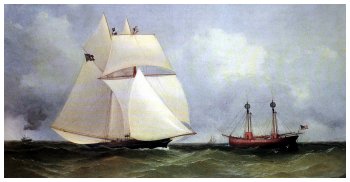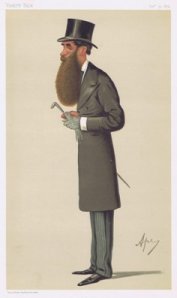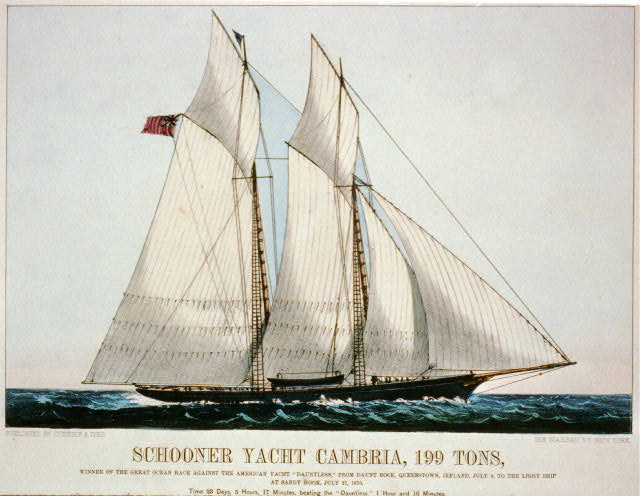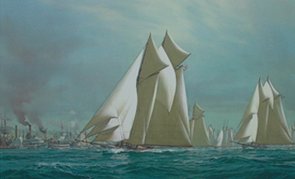Yves GARY Hits: 8273
Category: CAMBRIA
 First challenger of America’s Cup.
First challenger of America’s Cup.Cambria raced against a NYYC fleet of 14 boats. Magic won the race. Cambria finished 8th on elapsed time 27 minutes and 3 seconds behind the winner (and tenth on corrected time, 39 minutes and 8 seconds after Magic). The schooner was designed and built by Michael Ratsey at Cowes on the Isle of Wight, for James Lloyd Ashbury.
 The son of a Manchester wheelwright who had invented a railway carriage, James Ashbury was not content to have fortune. He was eager for social recognition and in particular those from the high society, which explains his membership in numerous British yacht clubs, such as the Royal Harwich and Royal Thames Yacht Clubs.
The son of a Manchester wheelwright who had invented a railway carriage, James Ashbury was not content to have fortune. He was eager for social recognition and in particular those from the high society, which explains his membership in numerous British yacht clubs, such as the Royal Harwich and Royal Thames Yacht Clubs.
In 1868, Ashbury appointed Michael Ratsey to build a 188-ton schooner christened Cambria – which was the name of the Cambrian Railway, a company in which James had some interest. The same year, the American schooner Sappho, owned by Richard Poillon, arrived in Cowes. A race was sailed around the Isle of Wight in which the cutters Condor and Oimara raced with the schooners Sappho, Aline and Cambria. It was Cambria who won the regatta; Sappho finished last, one hour and half behind the winner.For Ashbury, this success was encouraging: based on the result, he decided to challenge the NYYC for the Cup won by America in 1851.
His obsession for recognition prevented him from pushing for an 1869 match because he wanted Cambria to be the first British yacht to cross the Suez Canal, on November 17th, 1869. In the spring of 1870, Sappho, no profoundly improved, was again in English waters. On May 10th, 14th and 17th, she raced three matches against Cambria and won consistently. But this result did nothing to disturb James Ashbury who was at that time negotiating a transatlantic race to New York against the New York Herald Tribune owner, James Gordon Bennett with his schooner yacht Dauntless. This race would also serve as the delivery trip to America ahead of the first ever America's Cup race. After 23 days 5 hours and 17 minutes, Cambria, with Ashbury aboard, beat Dauntless by one hour and 43 minutes.
 Cambria became the first in a long line of challengers to be beaten in the America’s Cup. It was the only time when the challenge was contested in a fleet racing format in spite of Ashbury’s wish to race a single defender. No content with his defeat, in August 1870, the Englishman commissioned Michael Ratsey to build a new schooner for a new challenge.
Cambria became the first in a long line of challengers to be beaten in the America’s Cup. It was the only time when the challenge was contested in a fleet racing format in spite of Ashbury’s wish to race a single defender. No content with his defeat, in August 1870, the Englishman commissioned Michael Ratsey to build a new schooner for a new challenge.
In the meantime, Ashbury took his defeat sportily. A passionate yachtsman, he participated actively in the annual NYYC Cruise, sailed between New York and Newport and back. Cambria raced in numerous regattas. It often finished in second place and won just a single victory in a match race against Idler.
Endowed with a pointed sense of public relations, James Ashbury welcomed the President of the United States, General Ulysses S. Grant, for lunch aboard his yacht.
On the East coast the regatta season came to an end. After a last match raced and lost against Dauntless, Cambria sailed back to England. The schooner was quickly sold, and disappeared from the racing scene.
Its new owners were going to use it for trade, sailing for coastal navigation along the African coast. Cambria was lost at sea one day in a big, sudden storm.
 ... As the Cambria claimed to be the champion schooner in British waters last year, I kept an eye on her doings at both sides of the Atlantic, and think they fully justify that denial of her right to be so considered which I ventured to make in last year’s notes. In England she sailed in May two matches with Sappho and was beaten hollow, refusing to start in the third.
... As the Cambria claimed to be the champion schooner in British waters last year, I kept an eye on her doings at both sides of the Atlantic, and think they fully justify that denial of her right to be so considered which I ventured to make in last year’s notes. In England she sailed in May two matches with Sappho and was beaten hollow, refusing to start in the third.
• June 4th.—In the match of the New Thames Club to Harwich, was beaten without time allowance by Fiona and Egeria.
• June 8th—In the schooner match of the Royal Thames Yacht Club, was beaten without time by Gloriana, Egeria, and Flying Cloud.
• June 9th.—In the schooner match of the Royal London, was beaten by Egeria without time.
• June 10th.—In the schooner match of the New Thames, was beaten without time by Egeria, and on time by Flying Cloud.
• June 11th.—In the Royal Thames schooner match from the Nore to Dover, was beaten in very strong weather on time by Egeria.
• June 13th.—She won the Town cup from Dover to Boulogne and back.
• June 14th.—In the Royal London match for Mr. Broad wood's prizes from Dover to Cowes, was beaten without time by Fiona, Julia, Guinevere, Egeria, and Vindex.
She then started on 4th July, in her race to America, in which by better navigation or a luckier course she beat the Dauntless by one-and-a-half hours. In America, August 8th.—Was beaten for the cup won at Cowes, in 1851 by the America, by the Magic schooner and six others, including the old America herself.
• August 16th.—For a cup given by Mr. Ashbury himself, she was again beaten by the Magic, but won the second prize for schooners.
• September 8th.—She was a third time beaten by the Palmer for a cup given by Vice-Commodore Bennett, but again got second prize.
• September 10th.—For Newport cup in strong weather the Phantom, Palmer, and Dauntless beat her handsomely.
• September 28th.—For cups given by Mr. Douglas, Mr. Sturveysant, Mr. Ashbury, and the New York Yacht Club, she could do nothing with Dauntless, Tidal Wave, Madeline, Palmer, Idler, Alarm, and Madjie, who all beat her.
 In match making she was little more successful.
In match making she was little more successful.
• August 17th —In a contest 20 miles dead to windward and back she was beaten by the Palmer by 17m. 9s.
• August 18th —She beat the Idler in a similar match 8m. 43s.
• September 9th.—She was beaten by Phantom, 22m. 10s., and on same day by Madeline on time.
• October 18th.—She was trounced by Sappho to the moderate tune of 50m. 50s.
• October 19th.— She wound up her American score by losing to Dauntless by 11m. 30s.
Thus in England this year she sailed seven races and won one; two matches and lost both—in America she sailed five races and won two second prizes, six matches and won one, hardly good enough form to go so far to show off, while to judge from the accounts in your Magazine the handling was at times not much more remarkable than the result. The new vessel is described as likely to be fast, and is big enough to meet the American vessels likely to come over here on fairer terms, but is in point of size quite an over match for the vessels here except the Guinevere, and ought especially in channel races to have it all her own way...
